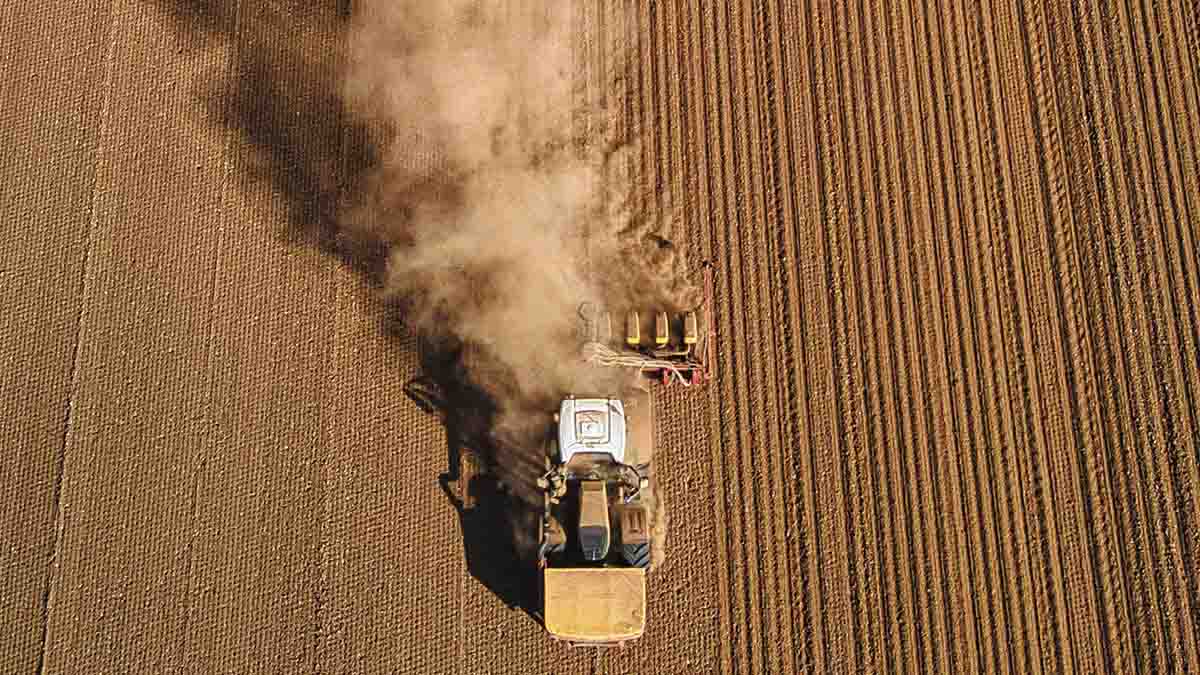Ag Practices and Air Quality
October 02, 2024
A University of Idaho researcher is leading a multi-institutional study evaluating how the adoption of farming practices aimed at conserving water, reducing erosion and improving sustainability is affecting air quality.
Alex Maas, a U of I associate professor in the Agricultural Economics and Rural Sociology Department, was inspired to study the issue while wiping away dust from the front porch of his Moscow home, which made him think about the large, dusty plumes that trail harvesters working on the Palouse.
Maas will be analyzing hundreds of thousands of daily readings dating back more than two decades from networks of air-quality sensors west of the Mississippi River to determine how weather, farming practices, harvest timing and land-use factors unrelated to agriculture align to affect air quality and human health. He’ll be working with Jim Crooks, an associate professor and climate epidemiologist at National Jewish Health, and Colorado State University researchers Jude Bayham, an assistant professor of natural resource and environmental economics specializing in air quality and wildfires, and Jeffrey Pierce, a professor of atmospheric science.
Results of the study could guide future land-use decisions, help water managers prioritize methods for conserving dwindling irrigation supplies and justify program incentives for agricultural sustainability practices. Maas proved the concept of the project with a $200,000 seed grant from USDA’s National Institute of Food and Agriculture (NIFA) and received a four-year, $800,000 USDA-NIFA grant in July to broaden his research.
In states such as Colorado and California, irrigators have faced broad curtailments due to drought-related water shortages. As a result, many farmers have left more land fallow and shifted toward low-water crops. Irrigated farmland is also rapidly being lost to development.
“The goal is to see the unintended consequences of our land-use decisions broadly, and this does have a lot of implications as we’re trying to deal with this water-scarcity crisis out West,” Maas said. “We’re looking at all land because you need to control for highways and cities and places that create a lot of air pollution on their own, but we’re only trying to investigate changes in agricultural land.”
Farmers are increasingly taking a long-term approach to management and implementing sustainable farming practices to stretch their inputs and minimize their environmental impacts, such as no-till and reduced tillage, conversion to more efficient irrigation technologies and the planting of cover crops. Cover crops are planted primarily to reduce erosion and improve soil health rather than for commercial sale.
The continuing shift toward low-water crops driven by water shortages is also significant. For example, potatoes have different fertility and input requirements than dryland wheat, which could affect nutrients and chemicals entering the air.
Maas’ project will use sensor data from the U.S. Environmental Protection Agency’s air-quality network, as well as a private network called Purple Air. He and his colleagues have developed a creative method for analyzing the data. They’ll note the agronomic practices and land-use decisions occurring within a pie-shaped area upwind of each sensor associated with each daily reading. In aggregate, the data should inform them how air quality is affected by specific farming practices, as well as what to expect when farmers change those practices.
“These choices are all connected, and as we’re trying to conserve water and potentially changing these choices, how can we incentivize and disincentivize activities that have implications far beyond the borders of your operation?” Maas asked. “If we suddenly see no-till is having this big impact on what we’re picking up with these air-quality sensors, now let’s go and try to figure out what the actual mechanism is and how we can encourage that, or maybe come up with new technologies.”
The project, “Partnership: Evaluating Risks from Agriculturally Sourced Emissions of Particulate Matter,” is funded with a four-year, $800,000 grant from USDA-NIFA, of which 100% is the federal share, under award No. 2024-67024-42698.

About the University of Idaho
The University of Idaho, home of the Vandals, is Idaho’s land-grant, national research university. From its residential campus in Moscow, U of I serves the state of Idaho through educational centers in Boise, Coeur d’Alene and Idaho Falls, nine research and Extension centers, plus Extension offices in 42 counties. Home to nearly 11,000 students statewide, U of I is a leader in student-centered learning and excels at interdisciplinary research, service to businesses and communities, and in advancing diversity, citizenship and global outreach. U of I competes in the Big Sky and Western Athletic conferences. Learn more at uidaho.edu.






